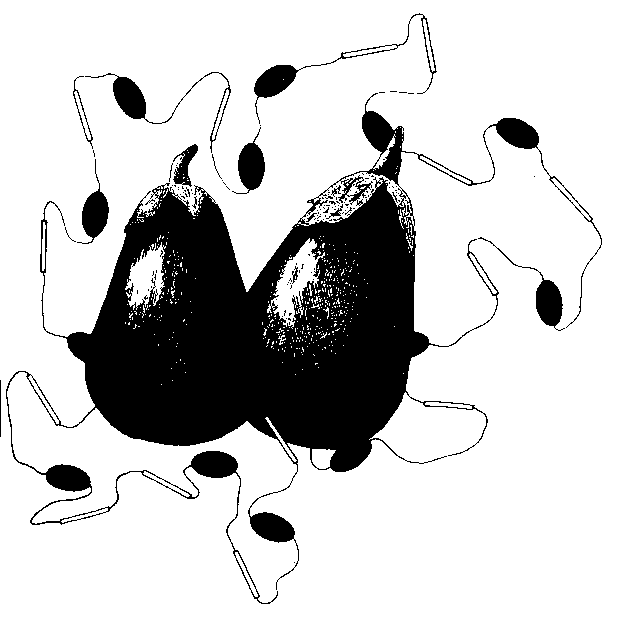
"We will not rest
until our
purple brethren
are freed
from the constant fear
of being
consumed"
--FETE, Federation
for the Ethical Treatment
of Eggplant
Autumn's very cool--
our hands busy peeling
melon and eggplant
--Matsuo Basho (1644-1694), from Narrow Road to the Interior
Some of Nasrudin's toddlers were playing around the house and someone asked his small son "What is an aubergine?" Immediately he said, "A mauve calf which has not yet opened its eyes." Delerious with delight, the Mullah gathered him up in his arms and kissed his head and feet. "Did you hear that? Just like his father! And I never told him--he made it up by himself!"
--The Exploits of the Incomparable 15th century Mulla Nasrudin, by Idries Shah.
In this warm spring rain,
tiny leaves are sprouting
from the eggplant seed
--Matsuo Basho (1644-1694), from Haiku
§ Home § Search § FoodTales § Any comments?
Eggplant
(Solanum melongena)
The eggplant, a member of the deadly nightshade family, is a vegetable of dubious origin. Some say it originated in China some 4000 years ago, then was introduced into the Mideast by Arab traders in the 8th century. Others say it originated and was domesticated in India, then brought home by members of Arab armies in the 7th century. Others yet say it has been grown and eaten as a vegetable in Iran since 1500 BC.
Nasrudin and a friend went to an eating house and decided for the sake of economy to share a plate of aubergines. They argued violently as to whether they should be stuffed or fried. Tired and hungry, Nasrudin yielded and the order was given for stuffed aubergines. His companion suddenly collapsed as they were waiting and seemed in a bad way. Nasrudin jumped up. "Are you going for a doctor?" asked someone at the next table. "No, you fool," shouted Nasrudin, "I am going to see whether it is too late to change the order."
Nasrudin had become a favorite at Court. He used his position to show up the methods of courtiers. One day the King was exceptionally hungry. Some aubergines had been so deliciously cooked that he told the palace chef to serve them every day. "Are they not the best vegetables in the world, Mulla" he asked. "The very best, Majesty." Five days later, when the aubergines had been served for the tenth meal in a row, the King roared, "Take these things away. I hate them!" "They are the worst vegetables in the world, Majestry," agreed Nasrudin. "But Mulla, less than a week ago you said that they were the very best." "I did. But I am the servant of the King, not of the vegetable."
--both from The Pleasantries of the Incredible Mulla Nasrudin, by Idries Shah
One of the oldest references to it occurred in China in the 5th century, when it was recorded on a scroll that Chinese ladies of fashion made a black dye from eggplant to stain their teeth--which, after polishing, shone like silver.
Little known in the ancient Mediterranean world, it was introduced into Spain and North Africa in the Middle Ages by Arab traders. Spanish explorers then carried it to the New World. It did not arrive in France as the glorious aubergine (from the Arabic al-badhinan) until the 17th century.
Americans are the only ones who call it "eggplant." They're "aubergines" to the French and British--from the Arabic bathinjan, which itself was Arabized from the Persian "badnjan"; "berenjena" to the Spanish and "berinjela" to the Portuguese, for the same reason; "melanzane" and "melitzane" to the Italians and Greeks, deriving from the 16th century scientific classification of mala insana, or "mad apple."

Interestingly, it is a sexual plant. You can differentiate easily, for males have a round "dot" scar in the depression at their blossom end, while females have a "dash" shaped scar. And the guys have fewer seeds.